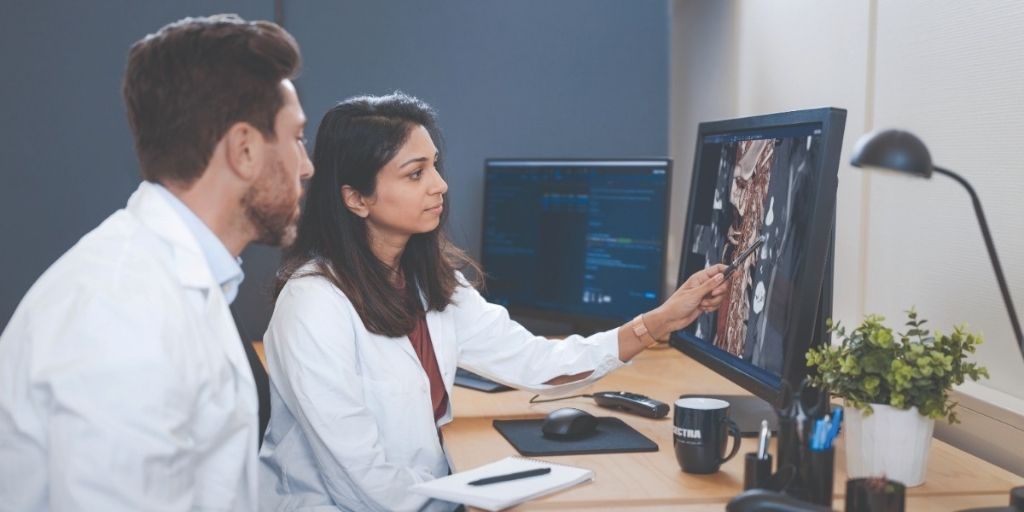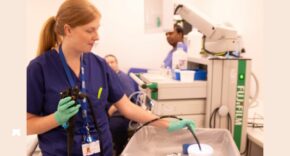
A consortium of NHS trusts that covers a population of circa 1.2 million will gain immediate access to important patient imaging, and will mobilise a regional workforce for patients, following a decision to procure a medical imaging system from Sectra.
Everything from x-rays to ultrasounds, CT scans, MRIs and more will become instantly available to relevant healthcare professions across five trusts in Surrey and Sussex, regardless of where in the consortium a patient has had their medical imaging captured.
This will help radiologists and other busy clinicians to make faster informed judgements for patients on a large range of clinical scenarios from cancer care to trauma cases and much more. The project will support faster turnaround of important diagnostic reports and will help scarce specialists to support hospitals across their region. The initiative will also help to avoid unnecessary duplicate scans and radiation exposure for patients, whilst removing the need for manual, time-consuming processes currently relied on in many parts of the NHS to share images between hospitals.
Dr Benjamin Salt, clinical lead for the consortium, who also works as a consultant interventional radiologist and deputy chief clinical information officer at East Sussex Healthcare NHS Trust, said:
“Some of the biggest benefits will be for patients who move around the region as they are referred to specialist centres at different trusts – whether that’s for cancer care, trauma, vascular medicine, ophthalmology, head and neck, plastics, liver, pancreatic surgery and more.
“Wherever in the group a patient has their scan, clinicians will have instant access to that imaging to inform their judgement, rather than having to request it to be uploaded and downloaded by imaging teams. For cancer follow ups, clinicians will have historical imaging immediately to hand. Important operations will be far less likely to face delay due to imaging availability, as will patient discussion at multi-disciplinary team meetings. And an emergency department in one hospital will be able to discuss imaging live with a specialist team at another site. We will be able to view and act on imaging in a way that we haven’t before.”
The project, initially focussed on radiology and mammography imaging, covers large parts of Surrey and Sussex and will see the Sectra system, known as a picture archiving and communication system (PACS), deployed as a cloud-based solution. This will lessen the technology burden on hospitals and create conditions for potential expansion to additional specialties to embrace the benefits of integrated diagnostics.
The trusts involved are: Ashford and St. Peter’s Hospitals NHS Foundation Trust; East Sussex Healthcare NHS Trust; Queen Victoria Hospital NHS Foundation Trust; Royal Surrey NHS Foundation Trust; and University Hospitals Sussex NHS Foundation Trust.
The system is also expected to link with two other trusts in the region and with London hospitals as needed, using open standards to make imaging discoverable and retrievable.
Dr Andrew Carne, a consultant radiologist, clinical lead and chief clinical information officer at Royal Surrey NHS Foundation Trust, said: “Improved access to imaging will allow us to support a flexible workforce that can deploy across a regional area – that has got to be good for staff, patients, and turnaround times of reports at a time when some hospitals lack capacity. A radiographer at one trust might have capacity to help reduce another hospital’s backlog. With a regionally integrated imaging dataset, that model becomes possible.
“We will also reduce unnecessary and harmful duplication and repeat capturing of imaging, including the radiation dose patients are exposed to. If you have had a chest x-ray in one part of the region and come to Royal Surrey, we don’t need to repeat it as we can instantly view it, along with imaging captured over a longer time period. This increase in reference data is important; if a small shadow appears on a chest x-ray, and on an image from several years ago, we can be reassured and don’t need to send the patient for further investigation unnecessarily. This is an important project for operational and financial efficiency in the region, and for patient safety.”
The new PACS will also remove IT complexity for staff. Third-party visualisation tools, which currently need to be opened in a separate screen, will now open and close in patient context in the PACS, removing the need to move from one system to another. PACS-based reporting will also help to minimise the number of systems radiologists need to log into and allow the generation of richer imaging reports with hyperlinks, graphs and pictures inserted, giving more information to the clinicians to accurately treat their patients.
And with AI playing an increasingly bigger role in radiology, the agreement with Sectra will make it easier for trusts involved to procure AI packages that will be integrated with the PACS.
Jane Rendall, managing director at Sectra in the UK and Ireland, said: “Diagnostic imaging often underpins important clinical decisions that make a difference to safe and effective patient care. Having access to that imaging in a seamless way is essential. Whether enabling better access to sub-specialist expertise or changing diagnostic models to improve the speed of decisions, the trusts we are working with in Surrey and Sussex have shown a commitment to ensuring the right image is available to be reported at the right time and by the right person, for the benefit of their patients.”
The contract comprises the Sectra enterprise imaging solution and will be used across the hospitals to review and store imaging acquired throughout the diagnostic process including community diagnostic hubs. The solution will handle approximately 1.7 million examinations per year.













